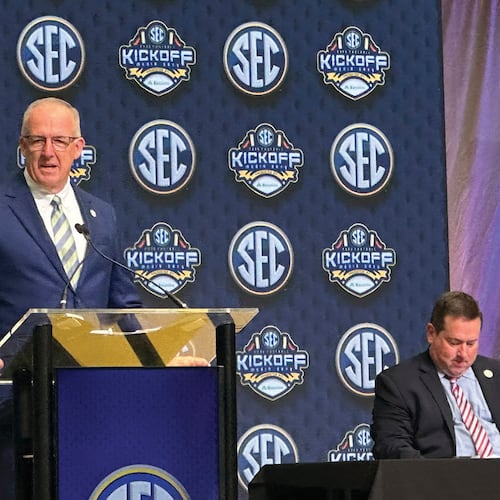The significance of Tuesday’s date – June 9 -- hit Scott Stricklin like a slap in the face. Informed that it represented the 30th anniversary of Georgia winning the 1990 College World Series, the Bulldogs’ baseball coach let out an audible sigh.
He more than anybody else knows full well that Georgia had perhaps its best chance in the three decades since of repeating that feat this year. The Bulldogs’ were ranked No. 2 in the nation when the coronavirus pandemic brought college baseball to a halt, as it did all sports. And the way they were built, with an incredible pitching staff anchoring a loaded weekend lineup, UGA was a favorite to reach Omaha for the 2020 CWS.
“You try not to think about it too much,” Stricklin said Tuesday morning. “But once a day, I have a little moment where I have to shake my head and shake it off and move on. Because, the thing is, there’s nothing you can do about it. It just stinks for our players and our team.”
The 2020 squad, as loaded as any Georgia team in recent memory, officially gets broken up Wednesday. That’s when the Major League Baseball draft commences and, piece by piece, the Bulldogs’ roster is expected to be dismantled.
Pitchers Emerson Hancock and Cole Wilcox, Georgia’s Friday and Saturday starters, respectively, are consensus first-round projections. Hancock, a junior, could be a top-5 pick. Wilcox, a draft-eligible sophomore, could go in the top 15. A host of other players are on teams’ draft boards as baseball plunges forward with a special five-round draft while its sport remains grounded.
“What might have been” for the 2020 Bulldogs officially ends over the next three days.
“I talked to the guys yesterday, and it’s kind of hitting them right now,” Stricklin said. “The draft’s coming up, and man, we should arguably still be playing. It makes it hard.”
There remains some hope that Wilcox might opt to return to college. The 6-foot-5, 232-pound right-hander has made it clear that he’s “not afraid” to return to school for another season of college baseball. So he is expected to take a hardball stance into post-draft negotiations.
Baseball America projects Wilcox to go to the Washington Nationals with the No. 22 pick. As an underclassmen, just because he’s drafted doesn’t mean he has to go. Still, it seems unlikely that Wilcox would pass on first-round money.
“Wilcox has a pretty steep asking price,” Baseball America wrote. “But, even so, many teams don’t expect him to return to college in the current landscape with so many teams having first-round evaluations on him. He has plenty of traits the Nationals like.”
Namely a fastball that has been clocked at 100 mph in games.
Hancock is the Bulldogs' prized catch this year. The 6-4, 213-pound junior was 2-0 with a 2.75 ERA and 34 strikeouts to three walks when the season was abruptly stopped in mid-March. He has a chance to become Georgia's earliest draft pick ever. Jeff Pyburn, picked No. 5 by San Diego in 1980, currently holds that honor.
It would be only the third time in school history Georgia has produced a pair of first-rounders, should the draft go as predicted. They would join Derek Lilliquist and Cris Carpenter (sixth and 14th) from 1987 and Gordon Beckham and Josh Fields (eighth and 20th) from 2008.
Georgia had 11 players selected in 2009 and eight last year.
Regardless, it appears likely that Georgia’s Nos. 1 and 2 starting pitching spots are going to be open next season. It’s further down in the draft order where the make-up of the Bulldogs’ team next season will be decided.
Pitchers Ryan Webb and C.J. Smith and position players Cam Sheppard and Tucker Bradley are projected in the 200th- to 300th-pick range. But with the draft reduced to only 160 or so players and signing bonuses restricted to $20,000 for free-agent acquisitions, the prospect of more players choosing to return to college seems likely.
With the added option of seniors being allowed another season of eligibility by the NCAA since they were unable to complete their final seasons, roster management is further complicated for Stricklin, as it is other college coaches.
No matter what, teams can field only 35 players, and they still have only 11.7 scholarships to divvy up among them. Meanwhile, Georgia’s 2020 signing class is already set.
“No one knows what’s next,” Stricklin said. “We just don’t know. The thing I’m looking forward to most about this draft is having a little more clarity about what our team is going to look like moving forward.”
And while it hurts to think about what might have been, Stricklin knew they were likely to be without many of these players anyway. The Bulldogs already have secured their 2020 recruiting class and are well on their way to locking down the 2021 group.
The best thing about losing lots of players to the draft is it tends to attract prospects who are hoping for the same thing.
“I had a conversation with all our draft guys yesterday, and I just said, ‘Hey, we’re all rooting for you,’” Stricklin said. “I told them if they decided to come back to Georgia, we’d love to have them. But we want what’s best for them. And ultimately it helps our program when you have first-, second- and third-round picks. Those guys get drafted and signed, then the next group of kids you’re recruiting sees that. They’re watching the draft, too.”
About the Author
Keep Reading
The Latest
Featured



